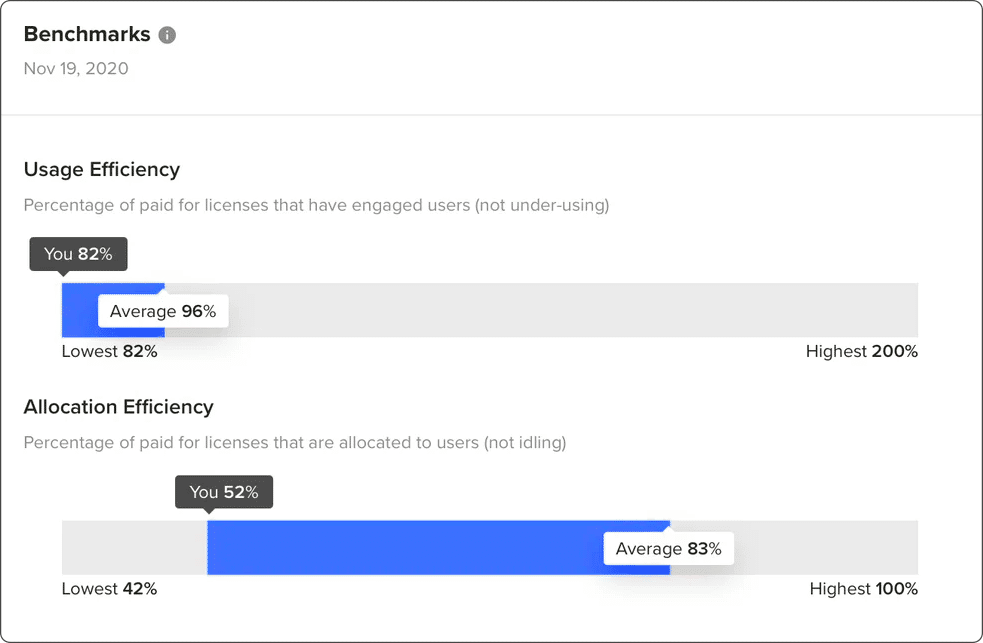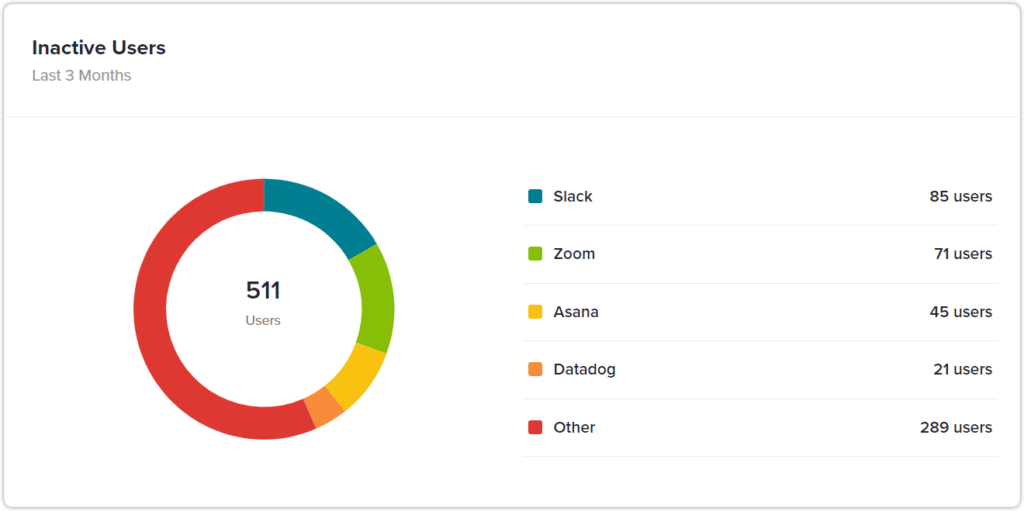Software sanity check: Track, reclaim, renew

You can’t make the right software purchase decisions, meet license compliance requirements, and keep an up-to-date software inventory without knowing how employees use different software solutions in your company.
As an IT manager, you also want to reduce expense overhead from unwanted software renewals and eliminate unnecessary programs. All that is only possible when you capture and analyze software usage tracking data.
Software usage tracking is the process of gathering, monitoring, and analyzing what software applications employees access and how frequently. Organizations typically collect this data from interacting with users directly, user activity records, application logs, and SSO or OAuth platforms.
Measuring how employees use software has multiple benefits. For example, tracking software usage enables you to unlock cost savings by telling you the exact number of licenses you need. You’ll also learn if employees are extensively using an application, which means that the tool is business-critical. Software usage monitoring also helps you comply with licensing agreements and flag the use of unauthorized software.
5 ways to monitor software usage at your business
While increasing productivity is a universal goal, it can be challenging without the right tools to accurately measure software usage. By tracking software utilization and pinpointing areas for improvement, you can help your team work smarter and get more done.
1. Monitor software renewals
As your tech stack evolves with additional SaaS tools, it may not always be possible to stay on top of renewal deadlines. Missed renewals not only hurt employee productivity, but also prevent you from accurately budgeting IT spending.
Visibility into upcoming renewals helps you optimize allotted seat numbers and negotiate better contract terms with each software vendor.
Sometimes, you may even run into tools that are set up with an auto-renewal status, meaning you could be billed annually, and automatically, for a tool that you don’t need anymore or one that you simply forgot about. Nothing’s more frustrating than signing up for a free trial then automatically being rolled into a paid subscription without even realizing it.
No matter which instance sounds the most familiar, when you keep track of upcoming renewals, you can better measure if that particular software tool is worth the money.
2. Verify if employees are using the software
Sure, this step in tracking software usage may seem obvious, but you’d be surprised by how many times this is forgotten about. With so many software options on the market, it’s easy to get distracted by the new and shiny application and then forget about the one you’ve been using for years.
Key metrics such as how long someone has used a certain tool or when their last login was helps you better assess if an application is necessary for your team or if similar features can be found in an alternative tool.
Strategic IT resource allocation is all about tracking software usage.
For example, you may need to buy additional licenses when more people use a tool than the number of licenses you paid for. Similarly, you may need to find alternative solutions when teams don’t use a tool as much.
What if you know a software is critical, but usage patterns don’t align with expectations? Beyond potential savings opportunities, software usage patterns can help IT determine which employees can benefit from additional training on a new tool.
3. Watch for new tools to be announced
The great big world of software is always changing. There’s always another software solution coming out and you never know when something awesome will hit the market.
Maybe it’s cheaper than what you’re using now or maybe it combines the functionality of two software solutions you use, all in one shiny product.
Either way, the next big thing could be just around the corner and you won’t want to miss out.
4. Measure productivity
Next, take a look at your tech stack, also known as a software stack. Your tech stack is the combined software systems that are needed to complete your entire platform of tools so that no additional software is needed to support any of your applications.
When doing so, ask yourself some key questions:
- Do your employees find these tools easy to use?
- Are these applications accurate and reliable?
- Do you get consistent results when using these tools?
- Are these tools helping your company achieve your short and long-term goals?
- How often does the application experience downtime where it’s unable to be used?
Depending on your answers, you may find some ways to evaluate your tech stack for the better so your teams can experience more success.
5. Maximize ROI with a SaaS Spend Management tool
To help you measure your company’s software use, it’s in your best interest to make the most out of BetterCloud.
This complete SaaS and contract management tool allows you to manage software spend, contracts, account usage, and compliance — all in one place.
You’ll be able to easily measure metrics like:
- Unused applications, instances, and shadow IT
- How much of your budget is being spent by department
- When contracts are up for renewal
- Which applications are being used and how often
How BetterCloud highlights clear software usage monitoring
When you use BetterCloud to measure how your company is using specific software tools, you’ll have a better idea of where you can improve, save money, and cut back.
Not every tool you invest in is going to be a perfect fit, but with BetterCloud, everything you need to measure whether or not you’re using the right software will be all in one place.
BetterCloud integrates with SSO and OAuth platforms to help you with software usage monitoring and see whether employees are using assigned applications. This real-time software usage tracking data goes a long way in helping you during license reclamation or contract rightsizing activities.
When software usage determines license changes
To optimize SaaS costs, companies often implement license reclamation.
License reclamation is the process of identifying and recovering unused or underutilized software licenses. When user data indicates that an application is no longer in use, IT can reclaim the associated license and can recoup the associated costs with the license come renewal season.
- Cost Savings: By reclaiming unused licenses, your business can significantly reduce SaaS expenses.
- Improved Efficiency: Ensuring that licenses are only assigned to those who need them improves overall operational efficiency.
- Better Budgeting: Accurate tracking of license usage helps in better budgeting and financial planning.
Best practices for license reclamation
As many in IT look to save on software spend, license reclamation is a great way to impact your bottom line.
Reclaim and re-assign licenses often
Once you’ve found unused or underutilized licenses, you’ll want to reclaim them or re-assign them to an employee that needs them.
With an IT automation tool like BetterCloud, you’ll be able to minimize the manual work behind license reclamation with BetterCloud’s powerful workflow engine to ensure all licenses are fully utilized and reduce the need to purchase additional licenses.
Negotiate with software vendors for any significant license reduction
Engage with SaaS vendors to negotiate better terms based on actual usage. Vendors may offer flexible licensing options or discounts for unused licenses.
In addition to analyzing your company’s software usage, it’s valuable to compare it to industry benchmarks. BetterCloud’s utilization metrics can help you understand how your software use stacks up against competitors.

Educate employees
Make employees aware of the cost implications of unused licenses and encourage them to release licenses they no longer need. This fosters a culture of responsible SaaS usage.
Conduct regular audits
Monitoring software spend is not a one time thing. You’ll want to regularly audit your SaaS usage so you can pinpoint licenses assigned to inactive employees, underutilized licenses, or departments with redundant applications.

Beyond SaaS Spend Management: BetterCloud’s comprehensive solution
BetterCloud is more than just a tool for managing SaaS spending.
BetterCloud streamlines your IT operations, automating tasks like employee onboarding and offboarding, license reclamation, and application access. Say goodbye to manual work and wasted software expenses.


